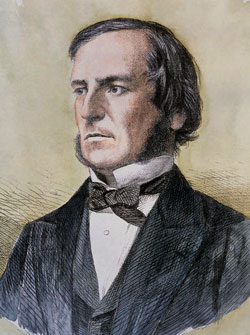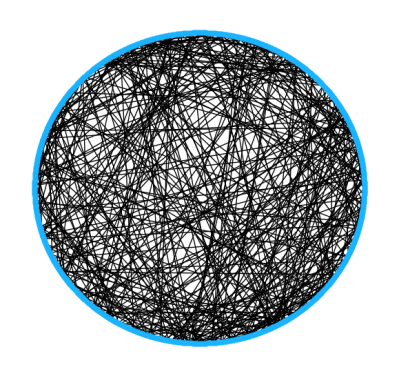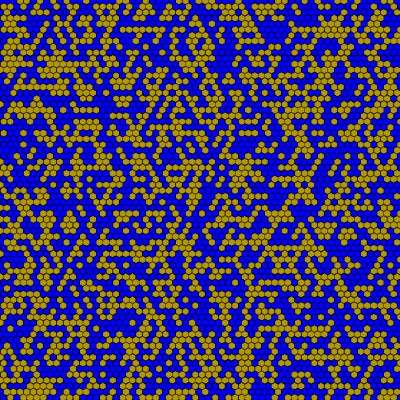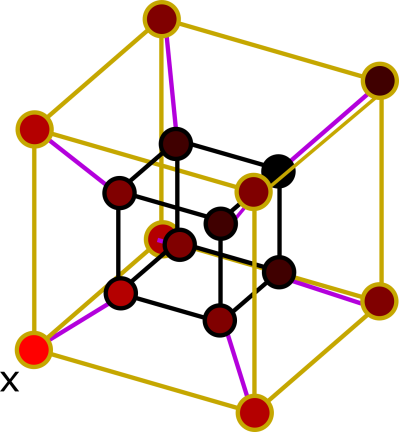I’m happy to say that my advisor Ronen Eldan and I somewhat recently uploaded a paper to the arXiv under the title “Concentration on the Boolean hypercube via pathwise stochastic analysis” (https://arxiv.org/abs/1909.12067), wherein we prove inequalities on the Boolean hypercube using a cool continuous-time random process.
That’s quite a mouthful, I know, and quite unfortunately, Boolean analysis is not a standard part of any math curriculum that I know of, be it at the undergraduate, high school, or kindergarten level. In this post I explain a bit about what Boolean functions are and what sort of games you can play with them; a sort of catastrophic cubic crash course, if you will. The next post will talk about our actual result.
For your Boolean convenience, here is a small table of contents.
Boolean functions
A Boolean function is a function which takes as input a vector of bits
and outputs a single bit. That is, it’s just a function
.
That’s it! Being so simple, Boolean functions can represent many things from many different disciplines, and it’s no wonder that they appear everywhere you look (though, as they say, what you see depends on what you are looking for, and this is especially true for mathematicians). To name a few examples:
- Social choice: A single bit
can represent the opinion of a voting-age citizen concerning some political matter, e.g whether or not Earth should break from the Intergalactic Federation (Earthxit). The vector
then represents the opinion of all
citizens, and a Boolean function
represents some way of deciding how to act based on those
opinions. There are many ways to do this, as can be seen by the diversity of different voting schemes in the different countries of the world. For most of you, I suppose, the most natural way to aggregate the opinions is via the majority function, which outputs
if
and outputs
if
(i.e outputs
if the majority of the inputs are
and vice versa). For others, perhaps a more natural option is the dictator function, which just outputs
for some index
, corresponding to the idea that only the opinion of person
matters.

- Algorithms: A very large portion of theoretical computer science and algorithms deals with concrete questions of the form “given some data structure, how do I know if it satisfies some property?”. For example, given a graph on
vertices, does it contain a Hamiltonian path? Is it a tree? Does it contain a clique of size
? Is it 4 colorable? Is it isomorphic to some other graph? Is it planar? And many more. Now, a graph on
vertices has a maximum of
potential edges, and it is completely described by stating which of those edges appear, and which don’t. So a graph can be identified with a vector
where each bit
corresponds to some possible edge:
if the edge is in the graph, and
if it is not. Thus, each “graph property” you can think of gives rise to a Boolean function.
For the connoisseur: Of course, the same is true not only for graphs; any Turing machine (which halts) gives a function on
bits. But I’d like to stay away from the stratosphere, since if we keep things too abstract we lose sight of the road and of practical theorems. Graph theory and graph algorithm-related questions, as history has shown, provide a good supply of Boolean functions to study.

Does this graph contain a clique of size 10? - Percolation: Similarly related to the idea of “graph properties” but totally deserving an entry of its own is the percolation function. In this example, you start with a square which is divided into hexagons. Each hexagon is colored either blue or yellow, and so can be described by a single bit
. The percolation function returns
if there is a path of yellow hexagons from the left edge of the square to the right edge, and
otherwise. The quest to understand percolation has driven forward much of the theory of Boolean functions and their properties, as is explained in the aptly named informative book “Noise sensitivity of Boolean functions and percolation”.

Is there a left-to-right crossing of yellow hexagons? - Combinatorics: A favorite pastime of mathematical combinators is to take an
-element set
, and ask all sorts of questions about how its different subsets interact with each other, such as “what is the largest possible family of subsets of
so that no set contains the other?“. As it turns out, a family
of subsets of
can actually be viewed as a Boolean function, in the following way. Each
represents a subset of
, with
if element number
is in the subset and
otherwise. A family of subsets
then gives rise to a Boolean function
, with
if the subset represented by
is in
.
- And many more: There are a myriad other examples and uses. In fact, Boolean functions have already had a spotlight in this very blog, when I investigated random walks on the hypercube. Indeed, there are just too many to list. But that shouldn’t stop you from trying; as the saying goes, “The world is your oyster, and Boolean functions are the pearl”.
Inequalities
Mathematicians, being what they are, usually don’t care about any particular Boolean function and how to compute it, but rather are interested in general properties of Boolean functions, and how different properties relate to each other. And mathematicians, being what they are, have devised a fairly long list of properties and inequalities between them.One of the central quantities of a Boolean function is its influence, which is a measure of how important each individual bit is to determining the value of the function
. The definition is this:
Definition: Pick uniformly at random among all
possible vectors. The influence of bit number
on function
, denoted
, is the probability that
changes its value when you flip the
-th bit:
The dictator function shows well the purpose of this definition. For any input, flipping the
-th bit always changes the output, so the influence of the dictating bit
is
, while flipping any other bit does nothing whatsoever to the output, so the influence of the rest of the puny bits is
. Figuring out the influence of different bits for different functions is a fun game for the whole family. For some functions (such as majority), it is relatively easy; for others (such as percolation), you’re going to have to sweat a little.
The definition of influence uses elementary probability, and this is very common in the analysis of Boolean functions. For example, when faced with a new Boolean function, one of the very first questions you will ask is “is it balanced?”, meaning, does it output as often as it outputs
? You can quantify the bias of a function as
Having defined two different quantities, the first thing that a mathematician does is try to compare them. Here is a theorem, called the “Poincaré inequality”, which is true for all Boolean functions:
Theorem:
A much more powerful (indeed, revolutionary) inequality is the one proven by Kahn, Kalai and Linial in 1988.
Theorem (KKL): Let be the largest influence of
, i.e
. Then
Here is some fixed constant, and we don’t really care about its value.
We are usually interested in the behavior of these types of theorems when the number of bits goes to infinity (otherwise, there is only a finite number of functions, and so only a finite number of different values that
and
can get, and we can always pick
to be large enough so that the theorem trivially holds). And when the number of bits goes to infinity, we also want the maximum influence
to go to
, for quite the same reason. But as
, the factor
becomes very small! so for all interesting cases, the quantity in the right hand side of the KKL inequality is smaller than that of the right hand side of the Poincaré inequality; the KKL theorem is indeed the stronger of the two. It is still not tight for the majority function, but there are other interesting functions for which it is tight.
Fourier for all
The KKL inequality is the industry-standard, go-to inequality for Boolean functions; efficient, dependable, and quite importantly, analysable. Its most common proof showcases the mathematical gizmos and gadgets used in Boolean analysis. Let’s take a peek at them.At the core of everything Boolean lies the Fourier decomposition: Every function can be written as a multivariate polynomial:
- The brute force way: One way to “compute” the function
is to go over all possible vectors
, and ask, “is
equal to
? If so, then return
!” Mathematically, this amounts to writing
as the sum over the indicators of its inputs:
whereis the function which returns
when
and
otherwise. Luckily, this function can be written as a polynomial in the entries of
: For every bit
, the expression
is
if
(i.e they have the same sign) and
if
(i.e they have different signs). Since we need every bit
to agree with every bit
, we just have
Plugging this into the sum over indicators and summing over possible monomials instead of over possiblevalues then gives the decomposition. Note that some of the
may be
.
- The elegant way: Like everything elegant in the world, this way uses linear algebra. For a set
, denote
; this is called the “character” of
. A simple calculation shows that for
, the correlation between
and
vanishes:
Thus the set of charactersconstitute a complete orthonormal basis under the scalar product
, and so every function
(being a member of the
-dimensional linear space of all functions on
) can be written as a linear combination of characters
. To obtain the coefficients of the combination, all you need to do is take a scalar product again:
The second, elegant way has a few advantages. First, if you took a functional analysis course in kindergarten, it makes you feel proud to finally see it applied in a nontrivial discrete system. Congratulations! Second (and perhaps arguably more important), the connection to classical functional analysis automatically gives us access to a vast repertoire of theorems and results about this decomposition. For example, we immediately know that the decomposition is unique, or that an equality known as “Parseval’s identity” holds:
This is very neat; we have found a way to express the variance of a function using its Fourier coefficients. Perhaps, if the same thing can be done for the influences , we could compare directly between the two quantities and prove inequalities like Poincaré and KKL. For this, we use derivatives:
Definition: The -th derivative of a Boolean function
, writen
, is given by the difference of
‘s value when
takes the value
and
:
The derivative function can take on three possible values: , if
‘s value changes when flipping bit
, or
if it remains unchanged. So the square of the derivative,
, has value
if flipping bit
changes the output. Since
is just the probability of this thing happening, the influence is equal to
Hypercontractivity
Unfortunately, the KKL inequality requires more than basic manipulation of Fourier coefficients (indeed, it requires advanced manipulation of Fourier coefficients). The standard proof uses what is known as the “hypercontractive inequality”. Summed up in one cryptic sentence, this inequality tells you how different ways of sizing up a function (aka different norms) relate to each other when you smooth out the sharp features of the function (aka adding noise). Let’s see what all of that means.One important way of studying the influences of a function is to see how it changes under noise. You can write entire books on this topic (indeed, people have), so I’ll just present the basics here.
First, what is noise? Suppose that is a point in the hypercube. A random vector
is said to be
-correlated with
if each bit
is obtained from
by setting
with probability
, and setting
with probability
. In other words,
is like
, but each bit of has a chance of
of being “rerandomized”, i.e has a chance of being uniform random. When
, we just have
, since the probability to be rerandomized is
. When
, then
is just uniformly random, since the probability of being rerandomized is
, and when
is somewhere in between, then
is somewhere in between; the larger the
, the higher the probability that many bits of
agree with the bits of
. We often think of
as a “noised version” of
. This has a geometric interpretation: For small
values, most of
‘s bits should be identical to those of
, and so it is (physically) close to it in the hypercube.

Using this definition of noise, we can look at a “smoothed out” version of , where instead of looking at
, we look at
where
is a noised version of
. This is called the noise operator.
Definition: The noise operator of , denoted
, is defined as
I say that this is “smoothed” out because what it does in effect is take weighted averages over all the values of , where larger weights are given to points close to
, and smaller weights are given to points far away from
(since there is a higher probability for
to be close to
than far). For
, all the weights in the average are the same, and we just take a simple average of all the points in the hypercube, i.e
is the constant function
. For
, we take the average of only one point, and
. Another reason that that is
is called “smoothed” is that whereas the original function
takes values only in
, the noised version takes values in the continuous interval
. Smooth indeed 😎.
For the connoisseur: If you peek inside textbooks, you might see appear under the name “heat operator”. Indeed, you can imagine that a point
in the hypercube is a hot body (say, a hot potato), while all the other vertices are cold (say, cold potatoes). Imagine also that vertices transfer heat to each other via conduction, and every vertex transfers heat equally to all its neighbors in proportion to the temperature difference. In this case, it turns out that the temperature at a vertex
is proportional to the probability that
, where
is
-correlated with
.
It can sometimes be a bit hard to understand how behaves, but as usual, one way to study it is to see what it does to the Fourier coefficients. Since the expectation is linear, i.e
, we can apply
to each monomial in the Fourier decomposition of
:
While the noise operator certainly changes the values of , it does not change the expectation of
, so if we take a sum of
over all
and a sum of
over all
, we get the same result. Of course, this does not hold for averages over other quantities derived from
, for otherwise there would be no difference between
and
. For example, in general,
Definition: Let . For
, the
-norm of a function
, denoted
, is defined as
The -norm is important in many branches of analysis, and Boolean analysis is no exception. The friendliest norm you can find is the
-norm: Its cheerful disposition arises mainly from Parseval’s inequality, from which we learn that
For the connoisseur: The keen-eyed among you will have noticed that the inequality between norms is exactly the opposite of norms for functions on (and general normed spaces); in those cases, we have
for
. The reason for this reversal is the introduction of the
factor by the expectation for the Boolean case.
The inequality can be thought of as follows. As the name suggests, the
-norms are “norms”, as in, they can be used to measure distance. The norm
measures the “distance” of
from the constant function
, and the distance between two functions
and
is given by
. The inequality is then equivalent to saying that the identity mapping between the space of all Boolean functions where distances are measured using the norm
and the space of all Boolean functions where distances are measured using the norm
is a contraction. More succinctly: The operator
is a contraction.
With this notion in mind, we come to perhaps the most famous theorem in the study of norms of Boolean functions, the “Hypercontractive inequality”. This is a really fancy-sounding, sex-appealing name for a theorem which relates the norm of and the norm of its smoothed version,
. It states that:
Theorem: For all ,
Since always, the subscript 2 is always larger than the subscript
, which means that the inequality goes in the opposite direction of the “inequality of the contractive identity”. In other words: Although the
-norm of
is always larger than the
-norm of
, the inequality is reversed if we smooth
out by
amount of noise. In even other other words: The noise operator
is a contraction! This is the origin of the overwhelming “hypercontractive”: The noise operator
is so good at equalizing and reducing the norm of a function, that not only is it contracting in its original space (i.e
), but it is even a contraction when comparing to otherwise smaller norms!
When I just started learning about Boolean functions, I didn’t know what all the fuss was about. After all, it’s just another inequality. But if there’s one thing that the analysts are good at, it is squeezing seemingly obscure inequalities to their very last drop of sweet, theorem-proving juice. Let’s see how that works out for the KKL inequality.
Proving KKL
Armed with the hypercontractive inequality, proving KKL is as easy as a brisk walk in anTheorem (KKL): Let be the largest influence of
, i.e
. Then
Assume for now that (we’ll show what happens when
afterwards). We start the same way we proved the Poincaré inequality, by writing
as a sum of Fourier coefficients:
This time, we’ll do something similar, but use a trick before multiplying by : We pick some number
(to be defined later) and divide the sum into two parts: All those
which are smaller than
, and all those which are larger:
(And what if ? Well, in that case,
, so in this case the KKL theorem is basically the Poincaré inequality in disguise, with a large constant in front of the influence term).
All in all, I think this is a nice proof. The choice is of course arbitrary; we could have chosen a different noise level, and gotten other constants in the various calculations. But the point remains the same: We found a suitable fixed noise level (or, “heating time”, if you think about
as a heat operator) where we could safely bound the smoothed-out versions of the derivatives. In the next post I will talk about my advisor’s and my new work, which shows how finding a random noise level can help you prove even more powerful versions of KKL-like inequalities.
Very nice blog post, enjoyed reading it! There may be a mistake in the formula after the paragraph that starts with “Recall what the heat operator…”. The rhs of this equation seems to be for \partial_i T_{\rho} f, not T_{\rho}\partial_i f — otherwise I think \rho has to be taken to the power |S|-1, not |S|.
Seems you are right. Fixed, thanks!